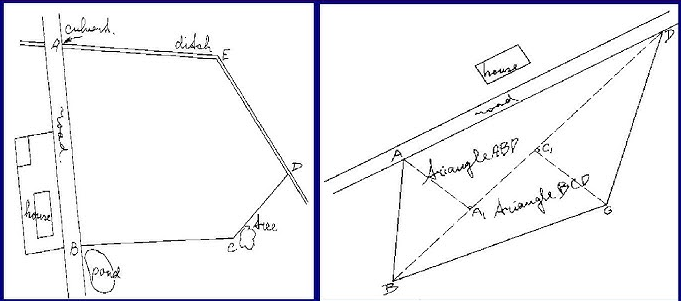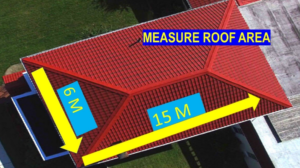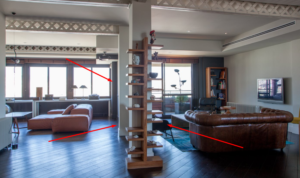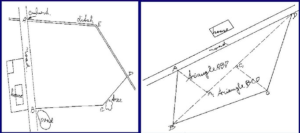
Measuring the area of sloped land can be more challenging than measuring flat surfaces. Whether you’re planning to build on a hillside, installing a garden, or simply calculating the land for agricultural use, understanding how to measure the area of sloped terrain accurately is essential. In this guide, we will walk you through the process with practical examples to help you get it right.
Step 1: Understand the Challenge of Measuring Sloped Land
The main challenge in measuring sloped land is that it’s not flat, so standard area calculations (like length × width) don’t apply directly. Instead, you must account for the slope, or gradient, to determine the correct surface area.
When measuring sloped land, you’re typically interested in the true surface area (the actual area you would walk on), which is different from the horizontal area (the flat, level projection of the land).
Step 2: Gather Your Tools
To measure sloped land, you’ll need a few essential tools:
- A tape measure or laser distance measurer
- A clinometer or a level to measure the slope angle
- A calculator for quick calculations
- A topographic map (optional) if the terrain is complex
Step 3: Measure the Horizontal Length and Width
Start by measuring the horizontal length and horizontal width of the land. These are the straight-line measurements as if the land were flat.
Example:
Let’s say you are measuring a piece of land for a small cabin, and the horizontal length is 30 metres, while the horizontal width is 20 metres. These measurements will give you the horizontal area (the area on a flat surface) of the land:
- Horizontal area = 30 metres × 20 metres = 600 square metres (m²).
Step 4: Measure the Slope of the Land
To find the actual surface area, you need to account for the slope of the land. The slope is usually given as a percentage or an angle. You can measure it using a clinometer, a tool that helps you determine the angle of the slope.
Example:
You measure the slope with the clinometer and find that it has a 10% incline (meaning the land rises 10 metres vertically for every 100 metres horizontally).
Alternatively, if you know the angle of elevation, you can calculate the slope. Let’s say the angle of elevation is 6 degrees.
Step 5: Calculate the Surface Area of Sloped Land
Once you have the horizontal length, horizontal width, and the slope percentage or angle, you can calculate the actual surface area of the land.
Formula for Surface Area (when the slope is given as a percentage):
- Surface area = Horizontal area × (1 + slope percentage/100)
Formula for Surface Area (when the slope is given as an angle):
- Surface area = Horizontal area × sec(θ)
where sec(θ) is the secant of the angle, which you can calculate using a scientific calculator.
Example 1:
If the horizontal area is 600 m², and the slope is 10%, the calculation is:
- Surface area = 600 m² × (1 + 10/100)
- Surface area = 600 m² × 1.1 = 660 square metres (m²)
Example 2:
If the horizontal area is 600 m², and the slope angle is 6 degrees, first calculate the secant of 6 degrees:
- sec(6°) ≈ 1.003
- Surface area = 600 m² × 1.003 = 602 square metres (m²)
As you can see, the surface area increases as the slope increases, since you’re accounting for the extra surface area created by the incline.
Step 6: Account for Irregularities in the Terrain
If the land is not a perfect rectangle and has more complex shapes (like a triangle or irregular polygon), break it into smaller, more manageable sections. Measure each section’s horizontal length and width, and apply the slope calculation to each part.
Example:
Let’s say your land has a sloped area that can be divided into two sections:
- Section 1: Horizontal length = 15 metres, horizontal width = 20 metres, slope = 10%
- Section 2: Horizontal length = 15 metres, horizontal width = 10 metres, slope = 10%
For Section 1, the surface area is:
- Surface area = 15 m × 20 m × 1.1 = 330 m²
For Section 2, the surface area is:
- Surface area = 15 m × 10 m × 1.1 = 165 m²
Now, add the areas of both sections to find the total surface area:
- Total surface area = 330 m² + 165 m² = 495 square metres (m²)
Step 7: Double-Check Your Measurements
Once you’ve calculated the surface area, it’s always a good idea to double-check your measurements to ensure accuracy. Recheck the horizontal dimensions and the slope to make sure they were measured correctly. If you used the angle of elevation, verify that the angle was measured accurately using the clinometer.
Additional Tips for Measuring Sloped Land
- Use a Surveyor’s Tape for Better Accuracy: For larger areas or highly uneven land, a surveyor’s tape (which is longer and more durable) can help you take more accurate measurements.
- Map and Plot: If the slope is very uneven, consider using a topographic map to help you visualise the different elevations and calculate surface areas for each distinct area.
- Consider Local Regulations: For building or construction projects, make sure to check any local regulations regarding land grading and slope. These could affect the permissible slope angle or the method of calculation.
Measuring the area of sloped land requires accounting for the terrain’s incline to determine the actual surface area. By following the steps outlined in this guide, you can accurately measure the surface area of any sloped land for construction, landscaping, or agricultural projects. Remember to measure the horizontal dimensions, calculate the slope, and adjust your calculations to reflect the land’s incline. With these techniques, you’ll be able to confidently work with sloped land, whether it’s for building a house, creating a garden, or planning any other type of project.



